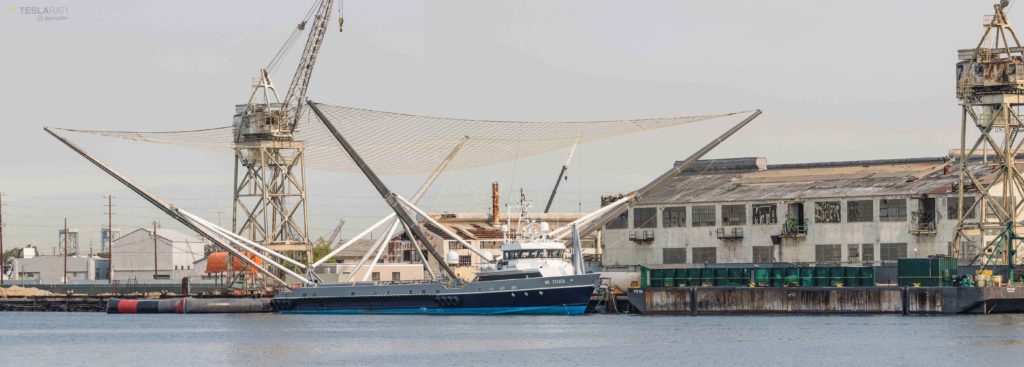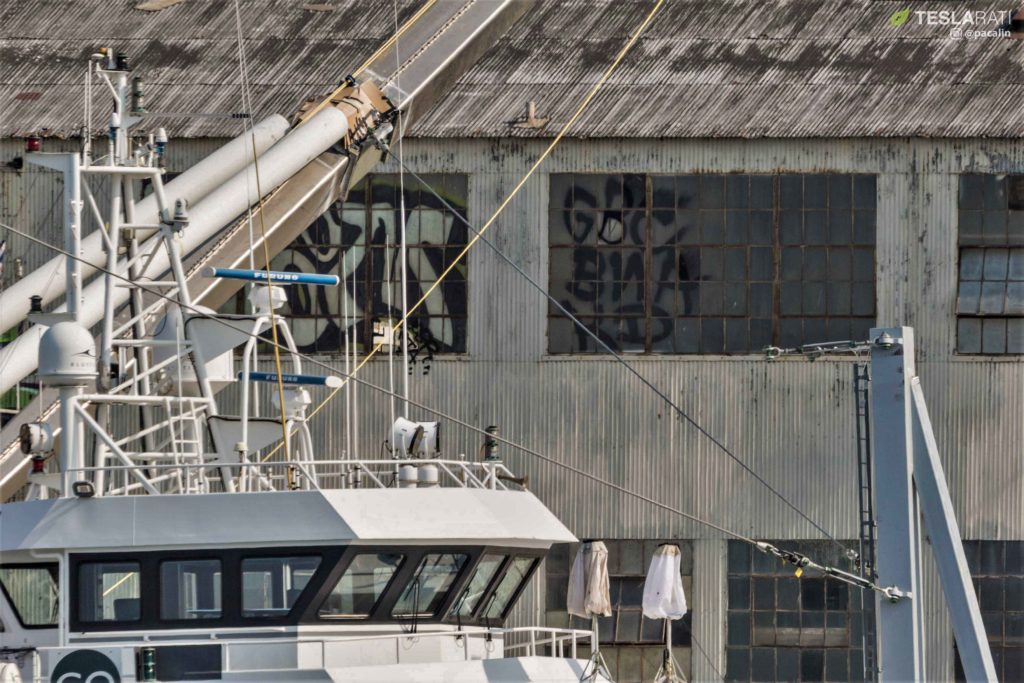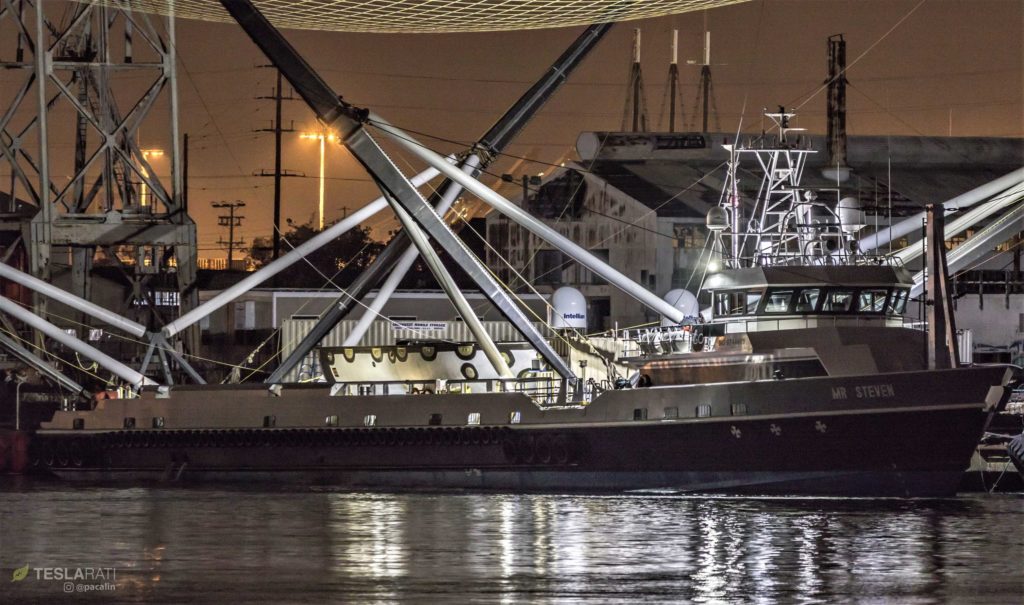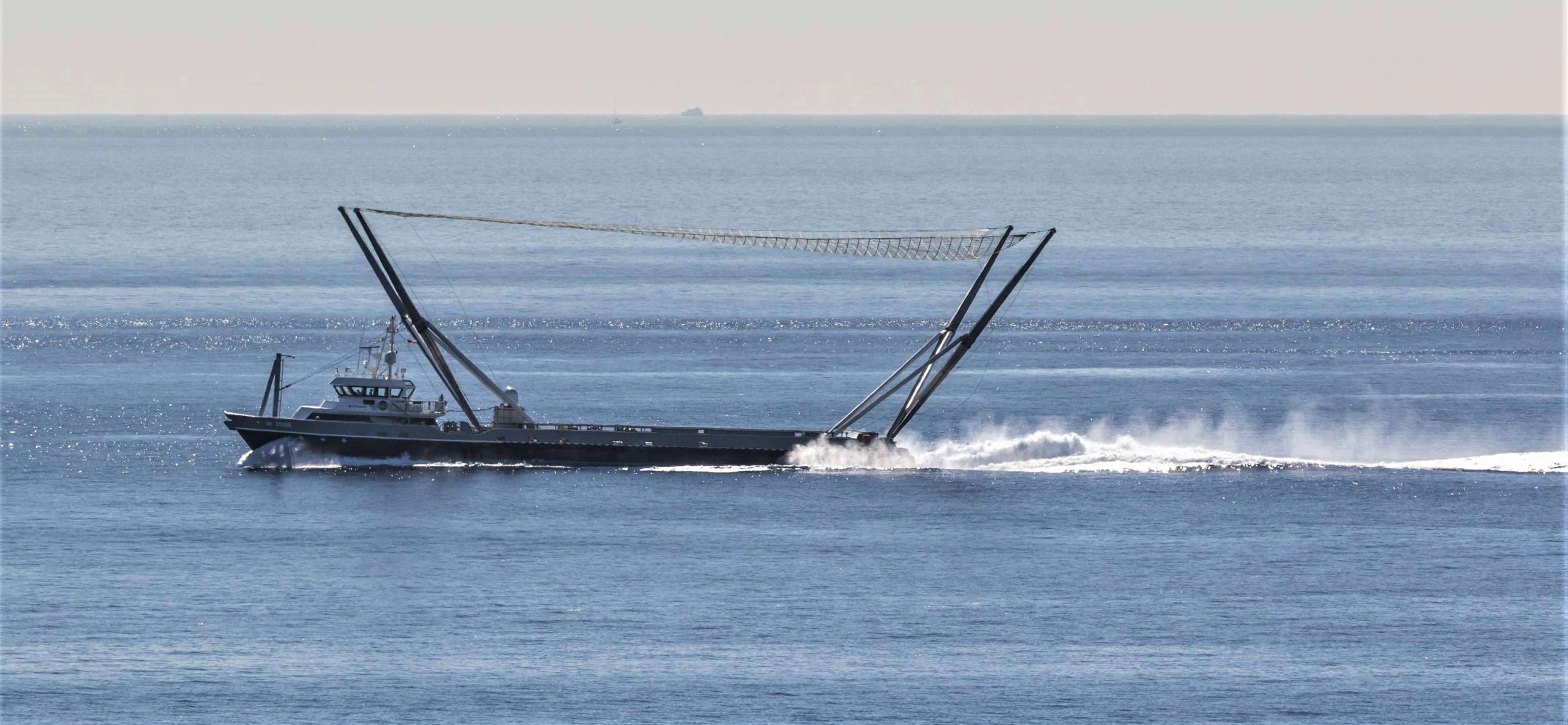
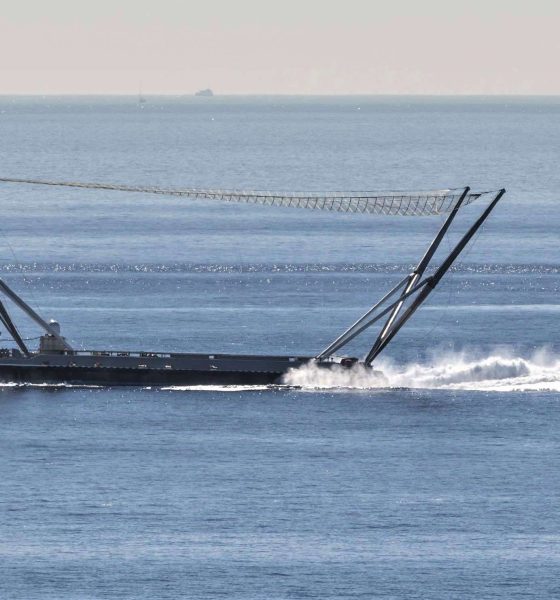
News
SpaceX Falcon fairing recovery vessel Mr. Steven tests out new limbs at sea
After a week or so spent installing a new and moderately ambiguous arm on the nose of Falcon fairing recovery vessel Mr. Steven, SpaceX’s recovery crew performed a number of high-speed sea trials a few miles off the shore of Port of Los Angeles, testing out something.
Just a few days later, Mr. Steven returned to the general region surrounding Catalina Island, where – by all appearances – SpaceX technicians performed the most recent Falcon fairing drop/catch test. Using a helicopter to pick up the test-dedicated fairing half from a barge, eventually dropping it from around 10,000 feet, this offers Mr. Steven a much higher volume of controlled attempts at both catching a parasailing fairing and optimizing the technology and recovery methods involved.
Mr Steven arriving back at port after some sea trials (with some new hardware near his nose). Such an elegant ship. The drop-test fairing is back in view on the dock as well. Soooooon……#spacex #mrsteven @Teslarati pic.twitter.com/qsmEy2Kk2a
— Pauline Acalin (@w00ki33) November 12, 2018
Over the last few weeks, Teslarati photographer Pauline Acalin has reliably kept up with Mr. Steven, documenting a variety of recent physical changes to the vessel. Most notably, these changes include the installation of a visible and quite curious stanchion (or arm) at the ship’s aft tip (nose). Simply due to a lack of any real information about the experiences of operating Mr. Steven and attempting to catch Falcon fairings, it’s all but impossible to know for sure what this new limb accomplishes or why it was needed in the first place.
Armed to the teeth
More clear are general visual observations and the reasonable extrapolations that can be derived from them. At the simplest level, this new limb is clearly well-reinforced, at least no less so than any of Mr. Steven’s other arms and attachment points. Aside from a basic off-the-shelf ladder for crew and technician access, the stanchion plays host to four basic swinging arms with what looks like one or maybe one and a half degrees of freedom, allowing them to pivot roughly 180 degrees along the plane of the angle they were installed at.
- An overview of Mr. Steven on November 10th, shortly after his new arm’s cables were attached. (Pauline Acalin)
- A good closeup of Mr. Steven’s new limb and its associated cables, cable linkages, and arm attachments. (Pauline Acalin, 11/10/18)
- A different view of the arm-cable attachment fixtures. (Pauline Acalin)
Secured to the ends of those four simple arms are four heavy-duty coiled metal cables, themselves attached to the center of Mr. Steven’s two foremost arms (two cables per arm). Curiously, the ship’s Nov. 12 sea trials were conducted with just the bottom two cables attached to each respective arm, visible in photos of the outing. Upon returning from a Nov. 14 fairing drop-and-catch test, both upper and lower cable sets were seen attached to his aft arms. During the nearby sea trials, no clearly abnormal behavior – compared against previous trials at similar speeds and the same location – was observed, although the new metal cables were visibly taut or nearly so.
Given just how seemingly nuanced the utility of this new arm and cable combo seems to be, a few obvious conclusions and possible explanations can be drawn. Perhaps Mr. Steven experiences inconvenient arm bouncing while sailing at high speeds, particularly in high speeds, and holding his arms down serves to grease the metaphorical gears of fairing recovery. Maybe the recovery net – stretched between four large arms – is tensioned more than SpaceX fairing recovery engineers and technicians would like, partially shrinking the usable catching area by pulling each arm towards the center. Even more nuanced still, it may be the case that these new tensioning steel cables and stanchion make it easier for fairing halves to be processed after landing in Mr. Steven’s net, allowing the crew to accurately and rapidly move the fairing to an optimal section of the net.
- (Pauline Acalin)
- Note the duo of cables connected to the arm attachment jig. (Pauline Acalin)
More questions than answers
Regardless, none of these best-case, simple explanations for the new hardware satisfactorily mesh with the known facts surrounding Mr. Steven and Falcon fairing recovery in general. For any of the above scenarios to be true, one must essentially assume that SpaceX has already nailed down fairing recovery and catches or believes that the path to solving those problems is almost totally clear of obstacles. If not, it would feel more than a little like putting the cart before the horse (or the fairing before the net) to be optimizing Mr. Steven for operations that are – as of yet – out of reach.
If SpaceX were so close to closing the fairing recovery gap, one would generally expect Mr. Steven to attempt fairing recoveries after all true Falcon 9 launches while also performing controlled drop test catch attempts. However, no such attempt was made after the October 7 launch of SAOCOM-1A and – according to CEO Elon Musk – Mr. Steven will not be attempting to catch Falcon 9’s fairing(s) after the imminent launch of SSO-A, expected to occur sometime after Thanksgiving (later this week).
Will try again next month
— Elon Musk (@elonmusk) November 14, 2018
For prompt updates, on-the-ground perspectives, and unique glimpses of SpaceX’s rocket recovery fleet check out our brand new LaunchPad and LandingZone newsletters!

News
Tesla (TSLA) receives “Buy” rating and $551 PT from Canaccord Genuity
He also maintained a “Buy” rating for TSLA stock over the company’s improving long-term outlook, which is driven by autonomy and robotics.

Canaccord Genuity analyst George Gianarikas raised his Tesla (NASDAQ:TSLA) price target from $482 to $551. He also maintained a “Buy” rating for TSLA stock over the company’s improving long-term outlook, which is driven by autonomy and robotics.
The analyst’s updated note
Gianarikas lowered his 4Q25 delivery estimates but pointed to several positive factors in the Tesla story. He noted that EV adoption in emerging markets is gaining pace, and progress in FSD and the Robotaxi rollout in 2026 represent major upside drivers. Further progress in the Optimus program next year could also add more momentum for the electric vehicle maker.
“Overall, yes, 4Q25 delivery expectations are being revised lower. However, the reset in the US EV market is laying the groundwork for a more durable and attractive long-term demand environment.
“At the same time, EV penetration in emerging markets is accelerating, reinforcing Tesla’s potential multi‑year growth runway beyond the US. Global progress in FSD and the anticipated rollout of a larger robotaxi fleet in 2026 are increasingly important components of the Tesla equity story and could provide sentiment tailwinds,” the analyst wrote.
Tesla’s busy 2026
The upcoming year would be a busy one for Tesla, considering the company’s plans and targets. The autonomous two-seat Cybercab has been confirmed to start production sometime in Q2 2026, as per Elon Musk during the 2025 Annual Shareholder Meeting.
Apart from this, Tesla is also expected to unveil the next-generation Roadster on April 1, 2026. Tesla is also expected to start high-volume production of the Tesla Semi in Nevada next year.
Apart from vehicle launches, Tesla has expressed its intentions to significantly ramp the rollout of FSD to several regions worldwide, such as Europe. Plans are also underway to launch more Robotaxi networks in several more key areas across the United States.
News
Waymo sues Santa Monica over order to halt overnight charging sessions
In its complaint, Waymo argued that its self-driving cars’ operations do not constitute a public nuisance, and compliance with the city’s order would cause the company irreparable harm.

Waymo has filed a lawsuit against the City of Santa Monica in Los Angeles County Superior Court, seeking to block an order that requires the company to cease overnight charging at two facilities.
In its complaint, Waymo argued that its self-driving cars’ operations do not constitute a public nuisance, and compliance with the city’s order would cause the company irreparable harm.
Nuisance claims
As noted in a report from the Los Angeles Times, Waymo’s two charging sites at Euclid Street and Broadway have operated for about a year, supporting the company’s growing fleet with round-the-clock activity. Unfortunately, this has also resulted in residents in the area reportedly being unable to sleep due to incessant beeping from self-driving taxis that are moving in and out of the charging stations around the clock.
Frustrated residents have protested against the Waymos by blocking the vehicles’ paths, placing cones, and “stacking” cars to create backups. This has also resulted in multiple calls to the police.
Last month, the city issued an order to Waymo and its charging partner, Voltera, to cease overnight operations at the charging locations, stating that the self-driving vehicles’ activities at night were a public nuisance. A December 15 meeting yielded no agreement on mitigations like software rerouting. Waymo proposed changes, but the city reportedly insisted that nothing would satisfy the irate residents.
“We are disappointed that the City has chosen an adversarial path over a collaborative one. The City’s position has been to insist that no actions taken or proposed by Waymo would satisfy the complaining neighbors and therefore must be deemed insufficient,” a Waymo spokesperson stated.
Waymo pushes back
In its legal complaint, Waymo stated that its “activities at the Broadway Facilities do not constitute a public nuisance.” The company also noted that it “faces imminent and irreparable harm to its operations, employees, and customers” from the city’s order. The suit also stated that the city was fully aware that the Voltera charging sites would be operating around the clock to support Waymo’s self-driving taxis.
The company highlighted over one million trips in Santa Monica since launch, with more than 50,000 rides starting or ending there in November alone. Waymo also criticized the city for adopting a contentious strategy against businesses.
“The City of Santa Monica’s recent actions are inconsistent with its stated goal of attracting investment. At a time when the City faces a serious fiscal crisis, officials are choosing to obstruct properly permitted investment rather than fostering a ‘ready for business’ environment,” Waymo stated.
News
Tesla FSD v14.2.2 is getting rave reviews from drivers
So far, early testers have reported buttery-smooth drives with confident performance, even at night or on twisty roads.

Tesla Full Self-Driving (Supervised) v14.2.2 is receiving positive reviews from owners, with several drivers praising the build’s lack of hesitation during lane changes and its smoother decision-making, among others.
The update, which started rolling out on Monday, also adds features like dynamic arrival pin adjustment. So far, early testers have reported buttery-smooth drives with confident performance, even at night or on twisty roads.
Owners highlight major improvements
Longtime Tesla owner and FSD user @BLKMDL3 shared a detailed 10-hour impression of FSD v14.2.2, noting that the system exhibited “zero lane change hesitation” and “extremely refined” lane choices. He praised Mad Max mode’s performance, stellar parking in locations including ticket dispensers, and impressive canyon runs even in dark conditions.
Fellow FSD user Dan Burkland reported an hour of FSD v14.2.2’s nighttime driving with “zero hesitations” and “buttery smooth” confidence reminiscent of Robotaxi rides in areas such as Austin, Texas. Veteran FSD user Whole Mars Catalog also demonstrated voice navigation via Grok, while Tesla owner Devin Olsen completed a nearly two-hour drive with FSD v14.2.2 in heavy traffic and rain with strong performance.
Closer to unsupervised
FSD has been receiving rave reviews, even from Tesla’s competitors. Xpeng CEO He Xiaopeng, for one, offered fresh praise for FSD v14.2 after visiting Silicon Valley. Following extended test drives of Tesla vehicles running the latest FSD software, He stated that the system has made major strides, reinforcing his view that Tesla’s approach to autonomy is indeed the proper path towards autonomy.
According to He, Tesla’s FSD has evolved from a smooth Level 2 advanced driver assistance system into what he described as a “near-Level 4” experience in terms of capabilities. While acknowledging that areas of improvement are still present, the Xpeng CEO stated that FSD’s current iteration significantly surpasses last year’s capabilities. He also reiterated his belief that Tesla’s strategy of using the same autonomous software and hardware architecture across private vehicles and robotaxis is the right long-term approach, as it would allow users to bypass intermediate autonomy stages and move closer to Level 4 functionality.
